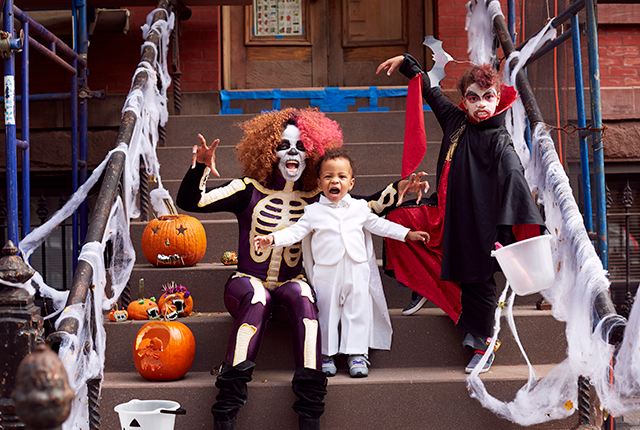
The science of scares: what makes us love fear
Fight, flight or freeze? A psychologist explains how the body processes the chills and thrills of Halloween.Media Contact: Chris Talbott - 206-543-7129, talbottc@uw.edu

Boo!
Nothing is quite as scary-fun as Halloween. People of all ages seek thrills and chills — and a little sugar, too — dressing up like vampires, goblins and ghosts. But what, exactly, happens in our brains and bodies when we play with fear?
It turns out our obsession has primordial origins in the fight-flight-or-freeze reflex, and lives in the same part of our brain as love and happiness. While we’re no longer running from sabertooth tigers, our fear responses are still hard-wired into the way we see the world.
We’re also chasing a chemical high, not unlike that sugar rush so many kids pursue each Oct. 31.
“Those adrenaline and dopamine releases that we get, they're also linked to pleasure centers in the brain,” said Michele Bedard-Gilligan, associate professor of psychiatry and behavioral sciences at the University of Washington School of Medicine. “For many of us, that feels fun and exciting to kind of have that type of reaction, particularly when it's happening in a space that we know is actually not objectively dangerous.
“I also think there's an element of it where that kind of scare, and surviving that kind of scare, leads us to feel good. We feel confident, right? Like, ‘We did it! We survived the danger.’”
Bedard-Gilligan studies fear and how we mammals react to it.
First, she said, we detect fear through the amygdala, an almond-shaped structure in the brain that is associated with emotions.
“Then, within the brain, other systems kick in and process the threat, as well — the hippocampus and the prefrontal cortex in particular,” Bedard-Gilligan said. “Those are the parts of the brain that do the higher order processing ... that help us figure out the context: Is this something that's actually dangerous?”
Once a threat is detected, stress hormones and neurotransmitters dopamine and adrenaline are released almost instantly to the body, where they cause that hair-raising, heart-pumping, sweat-inducing systemwide response we associate with having the jeepers scared out of us.
“All kick in and we feel all those things,” Bedard-Gilligan said. “And then all the things in the body that we don't need so much, like digestion, for example, kind of stop. And that gives us the reaction.”
That system has worked well for hundreds of millions of years as our species evolved from tasty and defenseless single-celled organisms to our current place atop the food chain. Humans’ highly developed sense of fear manifests in different ways. One is anxiety, which is becoming an increasing mental health issue. Another is thrill-seeking, which is what modern Halloween is all about.
At this point in our evolutionary process, we can tell the difference between authentic fear and industry-created scares like haunted houses and horror flicks, which makes the fright we feel Oct. 31 incredibly attractive to our subconscious.
“If you see a tiger in the zoo, you're going to feel really different because of that hippocampus and that prefrontal cortex that's working hard to tell you that that's not actually dangerous,” Bedard-Gilligan said. “Whereas if you see that same tiger out in the wilderness, then that amygdala is going to take over and you're going to feel pretty darned afraid, and our response for escaping danger is going to kick in.”
Another attractive thing about this time of year is the social aspect.
“It's very unique to our culture,” Bedard-Gilligan said. “Other cultures celebrate it very, very differently. For some, it's really about the horror and the fear and the sort of immersing yourself in that. For others, it's really about the socializing and coming together as groups in neighborhoods and walking around and knocking on people's doors. That’s typically something we don’t do.”
After all, no one goes to a haunted house alone. That would be creepy.
“I think watching other people's reactions influences our own reactions,” she said. “Watching other people get scared at the same things that we're getting scared at or watching them react bigger or smaller than us, those are often social-building and connection-building and really are, I think, key reinforcing human interactions.”
Related: Download broadcast-ready video soundbites with Bedard-Gilligan.
For details about UW Medicine, please visit https://uwmedicine.org/about.